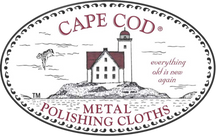Caring For Your Plated Metal
Brass on Wood
Plated Brass or Copper
Plated articles should not be confused with solid brass or copper. In brass and copper plated items, a coating has been applied to another metal usually steel but sometimes white metal (also known as "pot metal").
One way to determine whether an item is solid brass or copper is to test it with a magnet. If the magnet adheres then the metal is steel that has been plated. If it doesn't adhere, there is a good chance it is solid brass or copper unless it is "pot metal" (scratch the bottom - if there is white under the plate it is not solid).
Be particularly gentle with plated items, or you may totally remove the thin coating and expose the other metal underneath. Always test on an inconspicuous portion.
Most museum staffs now prefer that brass pulls and knobs not gleam brightly, but be allowed to tone down to a soft patina. If you want to shine them, remove them from furniture and rub with
Cape Cod® Metal Polishing Cloth (many old brasses are handmade and too fragile to be removed. In this case try to slip a piece of plastic or aluminum foil between brass and wood to protect the wood while polishing). Plated Brass or Copper
Plated articles should not be confused with solid brass or copper. In brass and copper plated items, a coating has been applied to another metal usually steel but sometimes white metal (also known as "pot metal").
One way to determine whether an item is solid brass or copper is to test it with a magnet. If the magnet adheres then the metal is steel that has been plated. If it doesn't adhere, there is a good chance it is solid brass or copper unless it is "pot metal" (scratch the bottom - if there is white under the plate it is not solid).
Be particularly gentle with plated items, or you may totally remove the thin coating and expose the other metal underneath. Always test on an inconspicuous portion.
